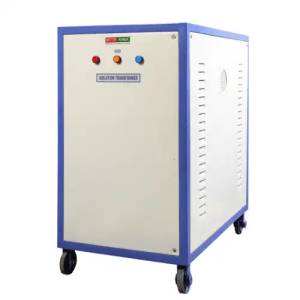Description
Isolation Transformers: Protecting Your Sensitive Equipment
Isolation transformers provide a crucial layer of safety and protection for sensitive electronic equipment by electrically isolating the input from the output. They prevent the flow of ground currents and surges, significantly reducing the risk of damage and ensuring reliable operation. This detailed description covers the key features, benefits, and applications of isolation transformers.
What are Isolation Transformers?
Unlike standard transformers that simply step voltage up or down, isolation transformers offer a complete galvanic isolation. This means that there's no direct electrical connection between the primary (input) and secondary (output) windings. This isolation is achieved through the use of a magnetic field to transfer energy, eliminating the conductive path that could allow ground faults, leakage currents, or surges to propagate.
Key Features & Benefits:
- Safety: The primary benefit is enhanced safety. Isolation transformers prevent electric shocks by eliminating the possibility of a conductive path to ground. This is particularly crucial in medical, industrial, and laboratory settings.
- Surge Protection: They act as a buffer against voltage surges and spikes, protecting sensitive equipment from damage caused by power fluctuations. This is especially important in areas with unreliable power grids or frequent lightning strikes.
- Noise Reduction: Isolation transformers can significantly reduce electrical noise and interference on the power line, improving the performance and stability of sensitive instruments and equipment.
- Ground Fault Protection: By isolating the equipment from ground, isolation transformers minimize the risk of ground faults, preventing damage and ensuring continuous operation.
- Improved Equipment Lifespan: By protecting against surges, spikes, and ground faults, isolation transformers extend the lifespan of connected equipment.
- Increased Reliability: The enhanced protection and reduced risk of damage contribute to increased system reliability and uptime.
Applications:
Isolation transformers find widespread use in diverse applications, including:
- Medical Equipment: Protecting sensitive medical devices from power line disturbances and ensuring patient safety.
- Industrial Control Systems: Protecting PLC's, sensors, and other critical components in industrial environments.
- Audio/Video Equipment: Minimizing ground loops and hum in audio and video systems.
- Laboratory Instrumentation: Protecting sensitive scientific instruments from power line noise and surges.
- Computer Systems: Enhancing the reliability and stability of computer systems, particularly in sensitive data centers.
- Testing and Measurement: Providing a safe and stable power source for testing and calibration equipment.
Specifications (Vary by Model):
- Input Voltage: Varies depending on the application (e.g., 120V, 230V, 480V)
- Output Voltage: Varies depending on the application (often the same as the input voltage)
- Power Rating (VA or kVA): Indicates the maximum power the transformer can handle.
- Isolation Level: Specified in kilovolts (kV) and indicates the dielectric strength between the primary and secondary windings.
- Frequency: Typically 50Hz or 60Hz.
- Efficiency: Measures the transformer's effectiveness in converting power.
- Mounting: Various mounting options are available, including benchtop, rack-mount, and wall-mount.
Choosing the Right Isolation Transformer:
Selecting the appropriate isolation transformer requires careful consideration of several factors, including:
- Input and Output Voltage: Ensure compatibility with your equipment's voltage requirements.
- Power Rating: Choose a transformer with a power rating sufficient to handle the connected load.
- Isolation Level: Select a level appropriate for the application and the level of protection required.
- Environmental Factors: Consider operating temperature, humidity, and other environmental conditions.
Conclusion:
Isolation transformers are essential components for protecting sensitive equipment and ensuring reliable operation in various applications. Their ability to provide galvanic isolation, surge protection, and noise reduction makes them a vital investment for maintaining the safety and longevity of your valuable assets. Consult with a qualified electrical engineer or specialist to determine the appropriate isolation transformer for your specific needs.
